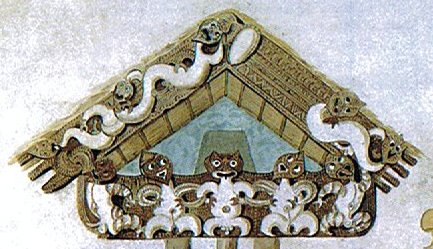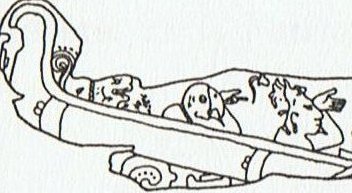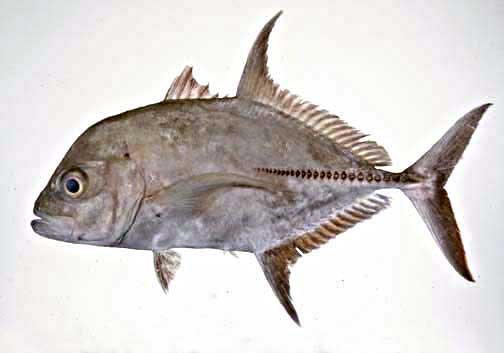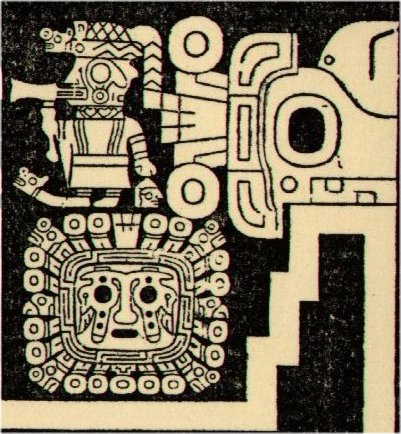|
TRANSLATIONS
|
The
role of the clashing rocks have now been made rather clear: In
order to let the poop remain on the surface without being
submerged the clashing rocks have bitten the ship in two. Only
the prow will now sink. Hatinga Te Kohe is the
corresponding kuhane station - the 'bamboo staff' (kohe)
is 'stepped on' by the kuhane and breaks:
| "he ata pe hiva he
hati te kohe i te vae" (Manuscript E according to
Barthel 2) |
"The dream soul was
careless (?) and broke the kohe plant with her
feet." (Barthel 2) |
In
a separate set of pages I will try to give a
translation better adapted to what we now know.
On
the surface remains the 'germ' of a new ship, or as it apparently is
described at the apex of the Taranaki store house:

The
terrified king (the 'Captain') is in the mouth of a beast, but his
'poop' ('doll') avoids the gap. His 'doll' remains inactive for a
time, but then gives birth to twins. Man and woman paddling a canoe
together will have the weaker one, woman, at the stern.
I
have been puzzled over why the rongorongo texts seem to say
that sun is sinking down instead of rising towards high summer.
Fists held high obviously indicate that all the 'fire' (fingers,
rima) still remain intact. In a cold climate and barehanded you
can keep your fingers warm by clenching them into a fist.
Later an empty hand
will show that no 'fire' is left. Maybe the empty hand of the 3rd
passenger in the solar canoe is the same type of sign:

Is it
the head of a turtle at the stern? Then comes a bird and then we are down
on earth.
The
'fire' in the sky (sun) is like other fires, they burn out. Yes. And
in midwinter no 'fingers' of the new sun are yet used up. Fists are shown to
prove it:
 |
 |
 |
7 * 52 =
364 |
|
Ab7-52
(1218) |
Ab7-53 |
Ab7-54 |
 |
 |
 |
 |
 |
|
Ab7-55 |
Ab7-56 |
Ab7-57 |
Ab7-58 |
Ab7-59 |
 |
 |
 |
 |
 |
|
Ab7-60 |
Ab7-61 |
Ab7-62 |
Ab7-63 |
Ab7-64
(1230) |
|
7 * 64 =
16 * 28 |
But why do they have to be held high? The sky in midwinter
is low. Maybe
the fists held high indicates the story is about the
sky 'fire'. Another explanation, hard to evade, is that
everybody knows gravitation brings things down. So the sun too
must come down, and we can see it every day when he sinks in the
west.
So
when sun sinks from a beginning high up in the sky and comes
gradually closer to the earth it will become warmer. At midsummer it is
really hot. Then sun must return up to his high position in the sky
again. But how can that be accomplished? He cannot move against the
force of gravitation.
The
answer is obvious. He has continued to sink beyond midsummer and he
has gone down into the depths of he sea. He moves very deep. But
at the lowest of lowest he cannot go any further. His momentum has
been used up. From such a deep, deep abyss, and with momentum now
'finished', the result is evident: he will start to rise again - his
buoyancy will make him move faster and faster towards the surface of
the sea. His spirit strives to move him upwards again, he is like a bird
who has dived for fish. And when he breaks the surface he will have gained
so much momentum that he will continue up into the sky to where he
once started.
This,
in short, is - I guess - what once was the explanation for the
movement of the sun over the year. Gravitation moves him down,
buoyancy moves him up.
The prow is the male part of the
ship and the poop the female part. The prow goes down, but the poop
sails on. Moon is always potentially visible, but Sun cannot be seen
during the night. He has only 'one leg'. The Ship (and by the law of correspondence also
every other ship) must be female.
A
Cherokee myth retold in The
Whirlpool in a way supports my interpretation, but also will
enable us to extend the model to include Mount Meru and to recognize
this important 'mountain' among the glyphs in the rongorongo texts.
|
|
The
task is complex. The law of correspondences has been used, I
think, to assemble a multitude of meanings to the crucial moment
when 'the staff is broken'.
| "he ata pe hiva he
hati te kohe i te vae" (Manuscript E according to
Barthel 2) |
"The dream soul was
careless (?) and broke the kohe plant with her
feet." (Barthel 2) |
The
proper translation is important and we must move forward slowly and with
caution. To begin with he ata it is fairly obvious
that he here is a definite article ('the'):
| He
He, article,
also verbal prefix. Hé, where? I hé,
where; ki hé, whereto; mai hé, wherefrom.
Vanaga.
Article. P Mgv., Mq.: e, the.
Sa.: se, id. Churchill. |
Ata is (as we have seen at ariki) possible to interpret
as 'shadow':
| ...
Whatever a in ariki means it is certain
that ariki means king. It would not surprise me,
though, if this suffix means 'son of', i.e. a-riki
= 'son to a regent' (cfr a in e.g. Hotu A
Matua). In Polynesia the eldest son of a king is
predestined to become a king in due time.
Ata-riki, can possibly be understood as the king of
the shadows (ata). But a shadow cannot exist in
utter darkness ...
The
meaning of ata is close to what we have learnt
about moe glyphs - they are located inside the
'threshold' to the 'room' of the new light. Although the
new luminant still is below the horizon its light can be
perceived, and therefore also shadows ... |
He
ata will then define the time of the event as early 'dawn'. When
the old 'staff, canoe' is breaking the new king must be on his way.
As to
he
hati te kohe i te vae we can - as a first reading - accept what
is suggested by Barthel: The breaking (he hati) of the
'bamboo' (te kohe) is caused (i) by the foot (te
vae) [of the kuhane]. Though both i and vae
have several interesting possibilities. I have redmarked a few
below:
| I
1. Preposition
denoting the accusative: o te hanau eepe i-hoa
i te pureva mai Poike ki tai, the hanau eepe
threw the stones of Poike into the sea. Te rua muraki
era i a Hotu Matu'a. the grave where they buried
Hotu Matu'a. 2. Preposition: for,
because of, by action of, for reason of...,
ku-rari-á te henua i te ûa the ground is soaked by
the rain; i te matu'a-ana te hakaúru i te kai mo
taana poki huru hare, the mother herself carries
(lit.: by the mother herself the taking...) the food for
her son secluded in the house. 3. Preposition:
in, on, at (space): i te
kaiga nei, on this island. 4. Preposition:
in, on
(time): i mu'a, before; i agataiahi,
yesterday; i agapó, tonight; i te poá, in
the morning. 5. Preposition: in
the power of: i a îa te ao, the command
was in his power. 6. Adverb of place: here. i au nei,
I am here (also: i au i , here I am, here).
Vanaga.
Î. Full;
ku-î-á te kete i te kumara, the bag is full of
sweet potatoes. 2. To abound, to
be plentiful; ki î te îka i uta, as there
are lots of fish on the beach. 3.
To start crying (of a baby): i-ûi-era te
ma-tu'a ku-î-á te poki mo tagi, he-ma'u kihaho, when
a mother saw that her baby was starting to cry she would
take it outside. Vanaga.
Toward; i muri oo na, to
accompany. Churchill.
Ii, to
deteriorate, to go bad. Churchill. |
|
Vae
Va'e: Foot, leg; te va'e
mata'u, te va'e maúi, right foot, left foot.
Va'e ruga, va'e raro, quick and light, without
detour (lit.: foot up, foot down). Ka-oho koe ki
a nua era va'e ruga va'e raro, ina ekó hipa-hipa,
hurry straight to your mother, do not make any
detours. Va'e pau, misshapen foot, clubfoot.
Vae, to choose. Vaega, middle, centre;
i vaega o, in the middle of. Vanaga.
1. Foot, paw, leg, limb; vae no
roto, drawers; karikari vae, ankle. P
Pau.: vaevae, foot, leg. Mgv.: vaevae,
id. Mq.: vae, id. Ta.: vaevae, avae,
id. 2. Pupil. 3. To choose,
elect, prefer, promote, vote; vavae,
to destine, to choose; vaea (vae 2),
pupil. Vaeahatu
(vae 1 - ahatu): moe vaeahatu,
to sleep sprawling with legs extended. Vaega,
center, middle, within, half; o vaega,
younger; ki vaega, among, between,
intermediate. P Pau.: vaega, the middle.
Mgv.: vaega, center, middle. Mq.: vaena,
vavena, vaveha, id. Ta.: vaehaa,
half. Vaehakaroa (vae 1 - roa):
moe vaehakaroa, to sleep with legs stretched
out. Vaehau (vae 1 - hau 3),
pantaloons, trousers. Vaeherehere (vae
1 - here 1), to attach by the paw. Vaerere
(vae 1 - rere 1), to run. Churchill.
Ta.: 1.
Timbers of a boat. Ha.: wae, knees,
side timbers of a boat. 2. To share out. Sa.: vae,
to divide, to share. Ma.: wawae,
to divide. Churchill. |
Presumably more than one meaning is expected to be understood by the
reader. On the personal plane the crying of a firstborn new baby
could be a reason for the old king to take a vacation,
to choose (vae) to leave his duties.
The
queen will similarly choose (vae) to give all her attention
to the 'pupil' (vae), the future king, the new 'timbers' (vae)
soon to be a great 'ship'. The queen will promote (vae) him.
The time is here divided (wawae) into a past (old king) and a
future (newborn child). The queen prefers the newborn and 'tramples'
on the old one.
|
|
The
dream soul (the Moon, the Queen of the Sun king) could indeed
have been 'careless' towards her old husband, because her
attention was now on the newborn prince:
| "he ata pe hiva he
hati te kohe i te vae" (Manuscript E according to
Barthel 2) |
"The dream soul was
careless (?) and broke the kohe plant with her
feet." (Barthel 2) |
Hiva is the 'old homeland', where the spirits of the dead
'live', or in general - another 'land' far away.
Pe
is the key word and hiva seems to be a following addition to make clear that the 'breaking' is not an event on Easter
Island proper but in the 'land of myth'.
|
|
In ancient Greece there once was someone - I remember having read a
long time ago - who proclaimed there were basic meanings
connected with each of the letters of the alphabet. I agree. Also according to my experience letters give clues as to what
the words containing them mean. But of course there is not much
practical help from such knowledge when the words have several
letters.
Pe
should be fairly easy though. Indeed, we shall begin with a similar
word, pi. Similar words tend to have similar meanings.
|
Pi
Mgv.:
pi,
full, complete. Mq.: pi,
id. Churchill.
Ta.:
pi,
young, green. Ma.: pipi,
half-grown, not matured. Churchill. |
In the following
I will argue for Mangarevan (and Marquesan) pi
= 'full, complete' being connected with our well known Greek
π.
If I am right, then the idea of 'full, complete' makes sense.
Given 'years' which
are only halfyears (which have only 1 'leg') it is enough to count the radius times a single π in
order to find 'circumference' of such a 'year'.
Maitaki
glyphs show halfcircles, though each such does not normally measure a 'year'
but a shorter time period, for instance a doublemonth:
|
 |
|
maitaki |
Fornander is useful:
PI,
v. Haw., to sprinkle, as water;
to throw water with the hand; pi-pi,
ka-pi, id.
Sam.,
pi, to splash, slap, as a fish in a
trap; ta-pi, rinse with fresh
water; pisi, to splash with
water.
Tah.,
pi-pi, sprinkle with water.
Sanskr.,
pi = pâ, to drink; piv,
id.; pinu, to sprinkle; pitha,
a drink, water; pipâsâ, thirst.
Greek,
πινω, to drink; πιστρα, a
drinking trough, drink, water;
πιπισκω,
give to drink; πωμα,
drink, liquor, &c.
Lat., bibo,
to drink;
bibulus,
potus.
Slav., pi,
piti,
pivati,
to drink.
The transition from the sense conveyed
in the Polynesian to that in the West
Aryan tongues will be intelligible to
those who have observed the manner of
drinking which probably obtained before
cups or containers were used, and which
is still very common among the
Polynesians when travelling; it is by
'throwing the water with the hand' from
the spring or river to the mouth. That
primary sense seems to have survived in
the Sanskrit
pinu,
to sprinkle.
|
With
the face as the 'living image' of the sun in the sky we can
understand the effect of throwing water into the mouth - some of it
will splash (pi) onto the face instead. The gesture will therefore tend to
have a magic effect on Sun. It will function like a rain dance and
when the rain comes the fires will go out.
Maybe
not. Drinking is an everyday matter. But I have shown how to
sprinkle with water easily can be associated with (connected to) the transition from high
summer to the season of rain. When Sun at the end of high summer is
thirsty, like the dry earth below, he will sprinkle water into his mouth.
This event coincides with the full measure given
by π (if we begin measuring at the correct time).
Anciently they often counted with
π = 3, for convenience sake. Therefore we ought to understand why
there are 300 days for Sun.
|
|
Several of the Polynesian dialects (though not Rapanui)
agree in pe meaning 'spoilt', no longer of acceptable
quality:
|
Pe
1. Like, as. PS Mgv.:
pe, as, the same as, also.
Sa.:
pei, like, as. Niuē:
pehe,
thus. 2. And, also (in numerals);
e rua
te hagahuru pe aha,
twenty-four. PS Sa.:
pe, a
restrictive particle in counting, only. To.:
be,
only. Uvea:
pe, id.
Churchill.
Pau.: Spoilt,
damaged. Mgv.:
pee,
macerated, spoilt. Ta.:
pe,
spoilt, rotten. Mq.:
pe, id.
Sa.:
pe, id.
Ma.:
pe,
pulpy, purulent. Churchill. |
On
Easter Island (and some other islands) the sense of pe is conjunctive ('like', 'and', 'also'). Samoa has pei for
this idea and pe for 'rotten', while Mangareva has pe
for 'also' and pee for 'spoilt'.
Te
Pei is where the calendar of G continues on the back side. Time
goes on, also (pe) when Sun has changed his habit to
become a Rain God. A conjunctive meaning surely is possible at Te
Pei. When Sun dives down into the ocean it becomes
comparatively dark.
Te Pei
... should probably read Te Pe'i ... The pe'i is a large, tasty fish
... caught in the deep waters
of the fishing grounds (hakanononga) ...

8 *
29.5 = 236 days counted from Gb8-30 will be 300 days if 64 days (from
Rogo in Gb6-26) are added. The reason for the 'black fish' is
that the fire in the sky
is finished. It has
reach its 'best before' limit, Sun has only (pe) 300 days.
Old Sun has therefore been
liquidated. In Ca3-10 we
presumably can see the watery mouth:
 |
 |
 |
 |
 |
|
Ca3-9 |
Ca3-10 |
Ca3-11 |
Ca3-12 |
Ca3-13
|
|
30 * 9 = 270 |
30 * 10 =
300 |
30 * 11 =
330 |
30 * 12 =
360 |
30 * 13 =
390 |
But
times goes on and Moon is still there and now she is pregnant.
It will be the same (pe) development once again.
Fornander:
PE,
adj.
Marqu.,
bad, impudent, naked. Ta., pe,
rotten, decayed. Sam., pe,
be dead, as trees,
extinguished, as
fire, dried up, as water. Haw.,
pe,
to crush, pound fine; pepe,
broken, bruised, pliable, rotten, soft;
u-pepe,
weak, feeble, dry. Fiji., be,
impudent, irreverent.
Benfey (Sanskr. Dict.) refers the Latin
pejor,
pessimus,
pecco,
to a Sanskrit word,
pâpa,
evil, wicked, sinful. The Polynesian
pe
apparently offers a better and more
direct root for
pejor,
pecco,
&c.
Benfey gives no root or etymon of
pâpa,
nor, if derived from
pâ,
to protect, to guard, how the transition
is made to wickedness, crime, sin. Here
as in so many instances, the Polynesian
supplies the missing-link in the
Hawaiian verb
papa,
'to prohibit, forbid, rebuke, reprove',
a derivative or duplicate of
pa,
'to fence, enclose, restrict'. And thus
the transition from the Polynesian
papa,
prohibited, forbidden, to the Sanskrit
pâpa,
sinful, wicked, becomes easy and
intelligible.
|
The
mystery of why Metoro said hakaturou at noon
is here presumably solved (because noon is corresponding to high
summer):
 |
|
Aa1-26 |
| ko te ahi -
hakaturou |
The
expression
'blasphemy' (hakaturou) seems to be connected to the fact that Sun is forbidden
(papa) to go on past his predestined limit. Papa is here pa
(fence, restriction) duplicated.
Pi,
pe, pa are basically a string of ideas relating to
the limit of Sun. Certainly we can also add po and pu.
Po
1. Night;
to get dark,
to fall (of night): he-po, it is
getting dark. Formerly used, with or
without raá, in the meaning of a
whole day: po tahi, one day;
katahi te kauatu marima po, fifteen
days; po tahi raá, first day of
the week; po rua raá, po toru raá,
second, third day, etc. 2. Alone or
as po nui, used to express the
idea of good luck, happiness.
He-avai-atu au to'ou po, I wish you
good luck (when taking leave of
someone). Very common was this parting
formula: aná po noho ki a koe!
good luck to you! Po-á, morning;
i te po-á, in the morning; i
te po-era-á, very early in the
morning. Po-ará, quickly,
rapidly, swiftly: he-iri po-ará,
go up quick; he-ta'o itau umu era
po-ará, he cooked it quickly.
Po-e-mahina, formerly used of
sleep-walkers (haha a po).
Vanaga.
1. Darkness, night,
late; po haha, dark night, gloom.
P Tu. po-tagotago, darkness.
Mgv., Mq., Ta.: po, darkness,
night. 2. Calendar day; po e rua,
Tuesday; po o te tagata,
life. P
Pau., Mgv., Mq., Ta.: po,
calendar day. Churchill.
|
|
Pu
1. To come forward to greet someone met
on the road; to walk in front,
to go in front: ka-pú a mu'a, let them go first.
2. Pú a mu'a, to intervene,
to come to someone's rescue; he-pú-mai a mu'a,
he-moaha, he came to my rescue and saved my life. 3.
Ancient expression: ai ka-pú, ai ka-pú, tell us
frankly what you think. 4. Hole, opening, orifice;
well;
circumference, rotundity; swirling water;
pú-haga, vaginal orifice; pú-henua (also just
henua), placenta. He pú henua nó te me'e aau,
he-oti-á; ina-á me'e ma'u o te rima i-topa-ai koe,
a placenta was all you had, it is a past thing now; you
held nothing in your hands when you were born (stern
words said to children to make them realize that they
must not be demanding, since they were born naked and
without possessions). 5. To dig out (tubers): he-pú i
te uhi, to dig out yams. Vanaga.
1. A trumpet.
P Mgv.: pu, a marine shell. Mq.: pu, conch
shell. Ta.: pu, shell, trumpet. 2. A small
opening, hole, mortise, stirrup, to pierce, to
perforate, to prick; pu moo naa, hiding place;
taheta pu, fountain,
spring; hakapu, to dowel, to pierce, to
perforate. PS Sa., Fu., Niuē:
pu, a hole.
Churchill.
Mq.: Pu, source,
origin. Ma.: pu,
root, origin, foundation.
Churchill. |
Pu as a trumpet makes me remember the Gateway of the Sun
in Tiahuanaco, where at the extremes of the year (the
solstices) two identical figures are depicted and they are
blowing trumpets. This is one of them:

We should notice
that these twin figures are looking inwards (like the moai on
Easter Island), and they presumably personify the limits of Sun.
And, remarkably, they appear to have beheaded the Sun - look how in
his left hand a head is dangling. The great sun head itself is
immediately below to make the association clear.
The immense bird
head at right has a sun type of eye (a black pupil in its
center), and above the eye is a 'helmet' divided in 3 parts. But in the crown of the
helmet there are 2 eyes which
ought to be the eyes of the moon. Their pupils are white.
Therefore also
the 5 + 6 * 2 = 17 similar moon eyes around the circumference of
the great sun head should be signs of lunar months: 147½ + 354 =
501½. But the circumference contains also 7 other signs. 7 *
29.5 = 206½, and 501½ + 206½ = 708 = 24 * 29.5.
However, a better
explanation is probably 24 * 29 = 696.
Fractions cannot be represented in the same way as units. 69 * 6
= 414 = 314 + 100. And 414 is also equal to Tama (14 *
29.5) + 1.
If we instead
count 6 * 96 = 576, we will have a nice solar square, 24 * 24.
|
|















